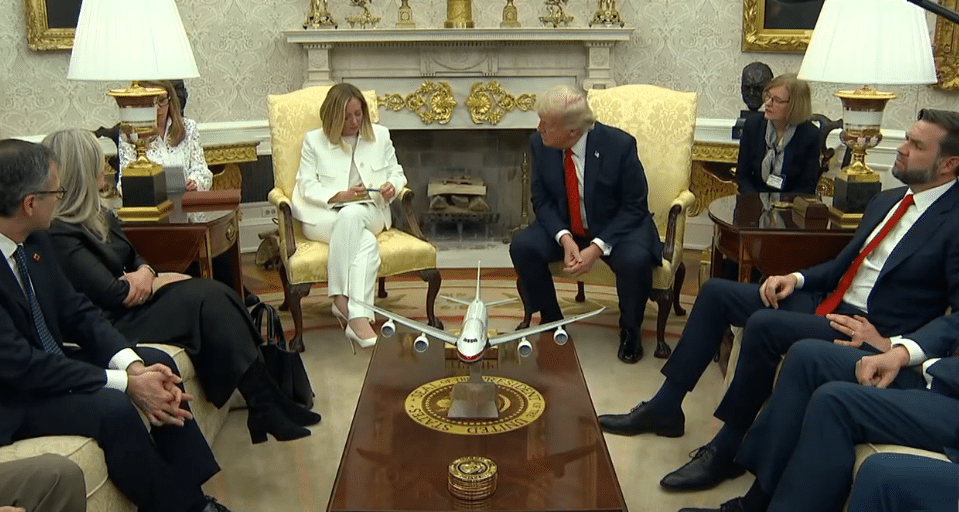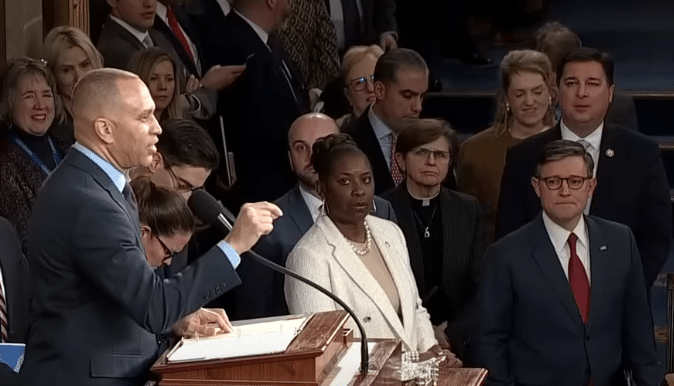
April 18, 2025
Permission to republish original opeds and cartoons granted.
Dealmaker-In-Chief: Conservatives Give Trump Room To Use Tariffs As A Negotiation Tactic For Better Economic Policies
| 
|
|
The data is in on how voters view President Donald Trump’s bold approach to trade and economic renewal, with a recent Harvard CAPS-Harris survey showing over half the country believes tariffs are necessary to correct an imbalanced global trade landscape. However, many voters also view President Trump’s tariff policies as a set of negotiation tactics with economic goals that go beyond the direct benefits the tariffs themselves will confer – benefits that include recouped revenue through the imposed tariffs and more competitive U.S. manufacturing. A majority of Americans believe the tariffs Trump is imposing are a strategic negotiation tactic intended to force more favorable financial agreements across the board, and voters are giving the president a wide berth to use tariffs as leverage in these negotiations. Americans say by seventeen points – 59 percent to 42 percent – that they believe President Trump is using tariffs as a negotiation tactic and may change them later. Republicans say Trump is using tariffs as a negotiation tactic by 32 points – 66 percent to 34 percent – and independents agree by 28 points. Democrats say by four points Trump plans to keep tariffs in place permanently, but nearly half of Democrats – 48 percent – also believe Trump is using tariffs as a negotiation tactic. |
Video: TRUMPS SECURES BORDER! Southwest Border Encounters At RECORD LOW As Trump Enforces The Law!
| 
|
|
Encounters on the southwest border of the U.S. with Mexico dropped to a record low of 11,017, according to the latest data by U.S Customs and Border Protection, the lowest ever on record in data dating all the way back to 2000. This was the second month in a row at these record lows since President Trump began his second term, with encounters on the border in February coming in at 11,709. Compared to a year ago, in March 2024, there were 189,359 encounters on the southwest border, and so being down to 11,017, that is a 94 percent decrease, proving to the American people and the entire world that border security is about the political will of the President more than anything else, with Trump declaring a national border emergency on Jan. 20 under the National Emergencies Act, deploying the military to the border, resuming construction of the southern border wall, declaring gangs and drug cartels to be terrorist organizations and expediting their removal under the Alien Enemy Act and by the Attorney General. As it turns out, it takes a president to enforce the laws Congress has already enacted, putting the lie to former President Joe Biden that he “needed” Congress to do something extra. |
Democrats Lead Generic Congressional Ballot, Just Like They Did In 2018 And 2006 With Republican In The White House
| 
|
|
Don’t look now, but believe it or not, just three months into office, we have already experienced 6 percent of President Donald Trump’s second term. By the end of the year, it will have been 25 percent and in 2026, the country will be once again swept up on the political cycle of periodic elections with the Congressional midterms looming. Right now, the generic Congressional ballot shows Democrats ahead in the national average of polls taken for 2026 compiled by RealClearPolling.com, with Democrats leading 45.8 percent to 44.3 percent. All six of the past six polls taken have shown Democrats leading the race. Even at this early stage — Republicans are still working on their tax cut and border security budget bill for crying out loud — it is in fact not too early to begin polling for the midterms, and sure enough pollsters are already taking up the task. That is because the usual, reliable measure for who’s ahead is the generic Congressional ballot, simply asking voters which party they intend to support in the next round of elections. How reliable? The average of generic Congressional ballot polls all predicted the winner of the 2002, 2006, 2010, 2014, 2018 and 2022 midterm elections and can even predict the rare, unusual event where the White House incumbent party is going to win the midterm elections. In midterm elections dating back to 1906 through 2022, the party that occupied the White House lost seats in the House 27 out of 30 times, or 90 percent of the time, and in years with losses those averaged 34 seats. It was only overcome in 1934, 1998 and 2002, with the Great Depression, Monica Lewinsky and the Sept. 11, 2001 terrorist attacks acting as exigent events. Another edge case is 1962, wherein Democrats only lost three seats, and came within weeks of the Cuban Missile Crisis being resolved. The general rule favoring the opposition in midterms is all James Madison’s constitutional scheme of periodic elections, explicitly designed to frustrate the ability of majorities to get things done. |
Dealmaker-In-Chief: Conservatives Give Trump Room To Use Tariffs As A Negotiation Tactic For Better Economic Policies

By Manzanita Miller
The data is in on how voters view President Donald Trump’s bold approach to trade and economic renewal, with a recent Harvard CAPS-Harris survey showing over half the country believes tariffs are necessary to correct an imbalanced global trade landscape.
However, many voters also view President Trump’s tariff policies as a set of negotiation tactics with economic goals that go beyond the direct benefits the tariffs themselves will confer – benefits that include recouped revenue through the imposed tariffs and more competitive U.S. manufacturing.
A majority of Americans believe the tariffs Trump is imposing are a strategic negotiation tactic intended to force more favorable financial agreements across the board, and voters are giving the president a wide berth to use tariffs as leverage in these negotiations.
Americans say by seventeen points – 59 percent to 42 percent – that they believe President Trump is using tariffs as a negotiation tactic and may change them later. Republicans say Trump is using tariffs as a negotiation tactic by 32 points – 66 percent to 34 percent – and independents agree by 28 points. Democrats say by four points Trump plans to keep tariffs in place permanently, but nearly half of Democrats – 48 percent – also believe Trump is using tariffs as a negotiation tactic.
In political circles, there has been a flair up of discussion surrounding the use of tariffs as part of an overhaul to global trade that will not only renew American manufacturing and increase revenue but could also push for America First economic policies in other areas.
In an April 7th opinion piece in the New York Times, historian Jennifer Burns suggested the Trump Administration may be using tariffs as a tactic to bolster their hand in negotiations that serve the American economy beyond the boost in revenue and manufacturing through tariffs.
Likewise, in a recent episode of NPR’s Planet Money, Greg Rosalsky discussed the possibility that tariffs may be a spoke in a larger wheel of economic reforms President Trump is planning to take. These reforms could include keeping the U.S. dollar as an international reserve currency while reducing the cost to Americans that reserve-currency status currently burdens us with.
While maintaining international reserve currency status confers many benefits to Americans, it also strengthens the dollar, which arguably makes U.S. exports more expensive and makes it more difficult for American manufacturing companies to compete globally.
One of President Trump’s top economic advisors, Stephen Miran, argued in a recent speech that, “reserve function of the dollar has caused persistent currency distortions and contributed, along with other countries' unfair barriers to trade, to unsustainable trade deficits.” Miran also stated that, “these trade deficits have decimated our manufacturing sector and many working-class families and their communities, to facilitate non-Americans trading with each other.”
According to this interpretation, a new approach to America’s role as the reserve currency to the globe may be in order, and tariffs may play an important role in negotiations by demonstrating that the United States is no longer going to be pushed around economically.
Americans who trust President Trump’s overarching vision for a renewed America First economy are giving the president room to use tariffs as one tool that could serve at least three major goals: recouping revenues through tariffs, strengthening U.S. manufacturing, and using tariffs as a negotiation tactic to demonstrate an unwillingness to allow the United States to be taken advantage of going forward.
Manzanita Miller is the senior political analyst at Americans for Limited Government Foundation.
To view online: https://dailytorch.com/2025/04/dealmaker-in-chief-conservatives-give-trump-room-to-use-tariffs-as-a-negotiation-tactic-for-better-economic-policies/
Video: TRUMPS SECURES BORDER! Southwest Border Encounters At RECORD LOW As Trump Enforces The Law!

To view online: https://www.youtube.com/watch?v=pEnVJPgUwc0
Democrats Lead Generic Congressional Ballot, Just Like They Did In 2018 And 2006 With Republican In The White House

By Robert Romano
Don’t look now, but believe it or not, just three months into office, we have already experienced 6 percent of President Donald Trump’s second term. By the end of the year, it will have been 25 percent and in 2026, the country will be once again swept up on the political cycle of periodic elections with the Congressional midterms looming.
Right now, the generic Congressional ballot shows Democrats ahead in the national average of polls taken for 2026 compiled by RealClearPolling.com, with Democrats leading 45.8 percent to 44.3 percent. All six of the past six polls taken have shown Democrats leading the race.
Even at this early stage — Republicans are still working on their tax cut and border security budget bill for crying out loud — it is in fact not too early to begin polling for the midterms, and sure enough pollsters are already taking up the task. That is because the usual, reliable measure for who’s ahead is the generic Congressional ballot, simply asking voters which party they intend to support in the next round of elections.
How reliable? The average of generic Congressional ballot polls all predicted the winner of the 2002, 2006, 2010, 2014, 2018 and 2022 midterm elections.
In 2002, the Real Clear Politics average of the last batch of polls taken had Republicans winning the popular vote 47.7 percent to 46 percent, and sure enough Republicans won the popular vote for the House of Representatives, except that it was by an even greater margin than forecast, 49.6 percent to 45 percent.
In 2006, the average of polls had Democrats leading the generic Congressional ballot 52.1 percent to 40.6 percent, although that overstated the outcome a bit, with Democrats winning the House popular vote 52 percent to 44 percent.
In 2010, the average of polls had Republicans leading 50.7 percent to 41.3 percent, also overstated a bit, with the final outcome being 51.6 percent to 44.8 percent.
In 2014, the average of polls had Republicans ahead, 45.6 percent to 43.2 percent, and Republicans won with 51.4 percent to 45.7 percent.
In 2018, the average of polls had Democrats ahead, 49.7 percent to 42.4 percent, and Democrats won with 53.3 percent to 44.9 percent.
And in 2022, the average of polls had Republicans ahead 48 percent to 45.5 percent, and Republicans won 50.6 percent to 47.8 percent.
So, the polls are fairly reliable during midterm elections, and can even predict the rare, unusual event where the White House incumbent party is going to win the midterm elections.
In midterm elections dating back to 1906 through 2022, the party that occupied the White House lost seats in the House 27 out of 30 times, or 90 percent of the time, and in years with losses those averaged 34 seats. It was only overcome in 1934, 1998 and 2002, with the Great Depression, Monica Lewinsky and the Sept. 11, 2001 terrorist attacks acting as exigent events. Another edge case is 1962, wherein Democrats only lost three seats, and came within weeks of the Cuban Missile Crisis being resolved.
The general rule favoring the opposition in midterms is all James Madison’s constitutional scheme of periodic elections, explicitly designed to frustrate the ability of majorities to get things done. But midterms are generally a turnout affair, where the opposition party, being out of power, has more a motivation to vote, and so they tend to do relatively better, picking up seats, but not always majorities.
To do that, the popular vote itself a reliable gauge of who won the majority. In 28 out of 30 midterm elections, or 93 percent of cases, the party that won the national popular vote for the House also won the majority for the House of Representatives, in 1906, 1910, 1918, 1922, 1926, 1930, 1934, 1938, 1946, 1950, 1954, 1958, 1962, 1966, 1970, 1974, 1978, 1982, 1986, 1990, 1994, 1998, 2002, 2006, 2010, 2014, 2018 and 2022.
The only exceptions were 1914, when Republicans won the popular vote but not a House majority, and 1942, when the same thing happened, both owing to the 100+ seat majorities Democrats had acquired in 1912 and 1940, respectively, giving them the overwhelming odds Democrats would retain House majorities no matter how poorly they did in the election.
So, to win the House, a party should endeavor to win the national popular vote. And to see who is winning the national popular vote, a good recent, reliable gauge has been the generic Congressional ballot.
And to break the midterm jinx, just a 1 in 10 chance for the White House incumbents, currently President Donald Trump and Republicans, appears in the rare instance to take an exigent event or failure from the preceding party intervening and favoring the White House incumbent party in Congress in the off-year election. The real key comes down to motivation by voters, and so turnout and enthusiasm are the key considerations.
Recently, even with record midterm turnout for Republicans in 2022, winning 54.2 million votes, amid public outrage over high inflation, the GOP almost lost that year — only picking up nine seats. Democrats were outraged by Roe v. Wade, which had barred states from curtailing abortions, being overturned by the Supreme Court. Nearly beating the midterm jinx, Democrats were able to motivate lower propensity voters in the off-year election that usually favors the opposition party.
As it is, we’re still in a garden variety cycle where Democrats, being out of the White House, have a 90 percent chance of picking up seats. For President Trump and Republicans, it will likely, barring an exigent event — something on the order of the Great Depression, the Cuban Missile Crisis, Monica Lewinsky or 9/11 — feel a lot like pushing on a string. As usual, stay tuned.
Robert Romano is the Executive Director of Americans for Limited Government Foundation.
To view online: https://dailytorch.com/2025/04/democrats-lead-generic-congressional-ballot-just-like-they-did-in-2018-and-2006-with-republican-in-the-white-house/
